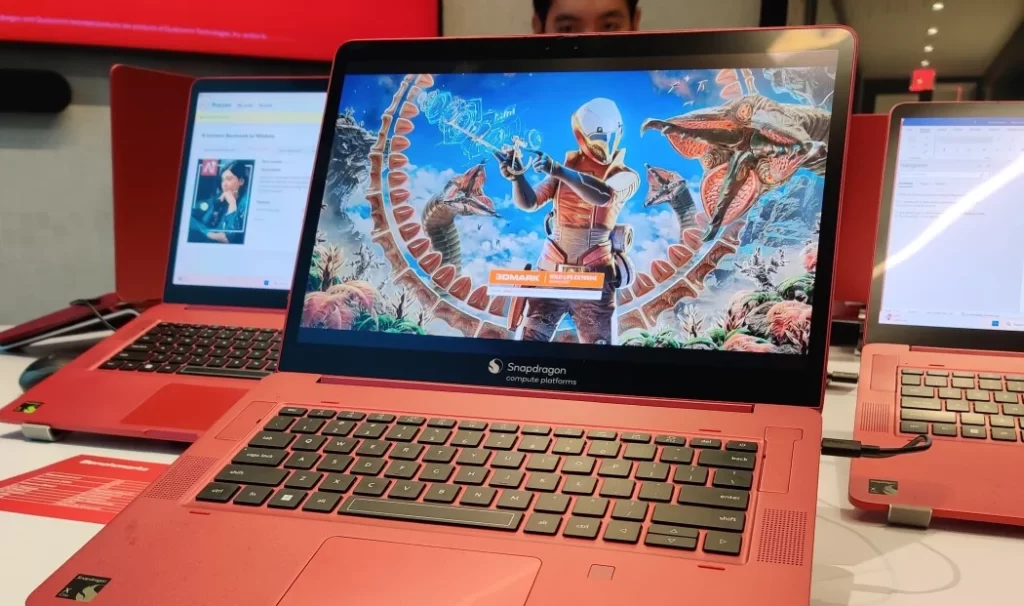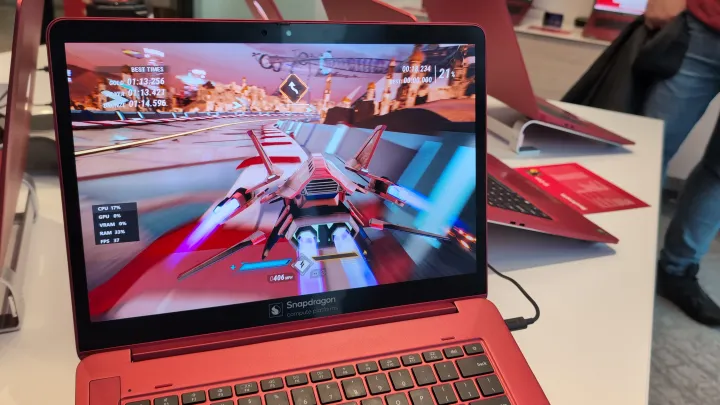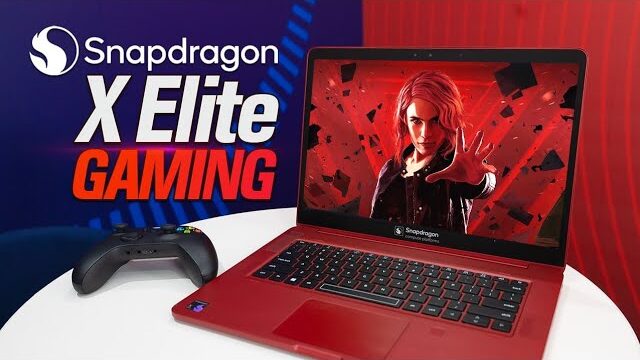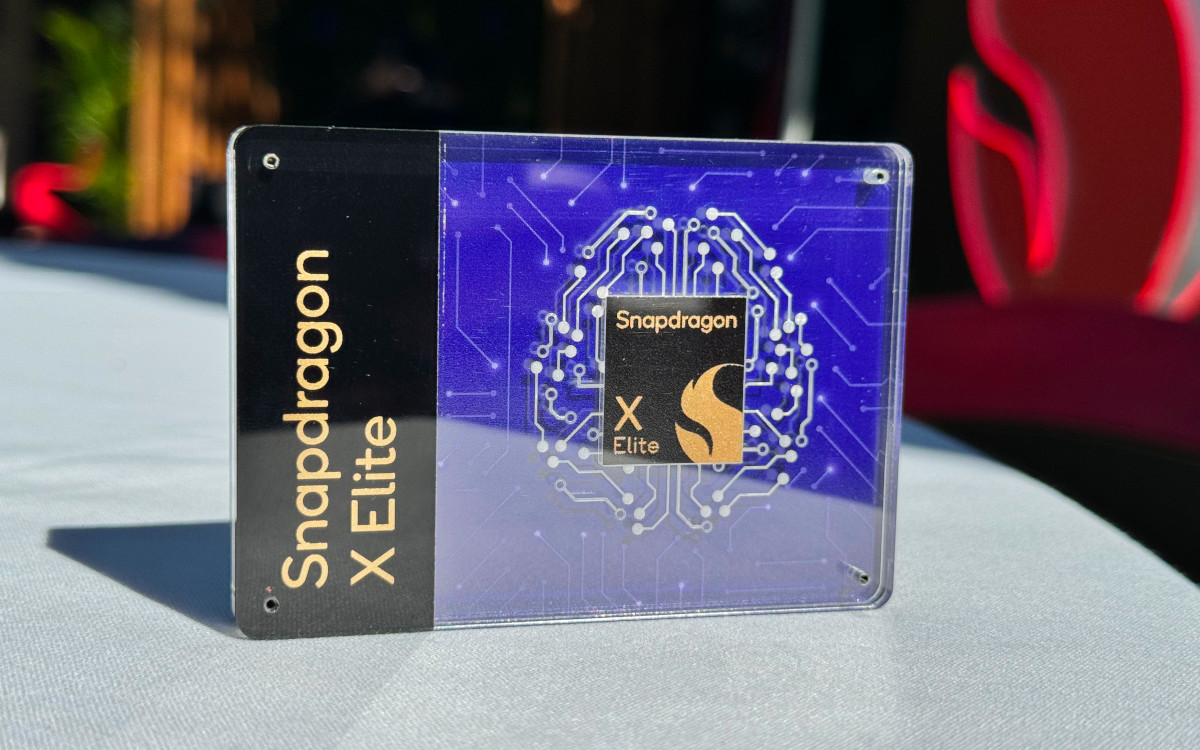Qualcomm’s Snapdragon X Elite chipsets, although not yet available in laptops, have already made waves. In recent hands-on demonstrations, these chips showcased their prowess across various tasks, including code generation, Da Vinci Resolve, and most notably, gaming performance.
The gaming demos were conducted on a custom-built platform featuring a 2.8K display and 32GB of RAM. Despite running games at 1080p resolution, the experience was remarkably smooth, with no dropped frames. What’s even more impressive is that these demos were executed using an integrated GPU, emphasizing the chipset’s capabilities.

- In the racing game Redout II, known for its demanding visuals, the Snapdragon X Elite chipset delivered buttery-smooth performance. Racing games are particularly sensitive to frame drops, making this achievement noteworthy. Even more surprising, considering the integrated GPU, was the flawless 1080p performance.
- In Baldur’s Gate III, a tactical RPG, the Snapdragon X Elite handled complex encounters seamlessly. Unlike lower-end systems that struggle with CPU bottlenecks during intense NPC interactions, this chipset remained unfazed.
- Remedy’s Control, a visually stunning game leveraging ray tracing technology, played smoothly on the Snapdragon chip. While the integrated Adreno GPU lacks ray tracing capabilities, Control’s visual appeal remained intact.
Check: Attractive Pictures
Also Read: Tiny11 23H2: The Best Lightweight Windows 11 for Gaming
Unveiling the Magic: Snapdragon X Elite Gaming Explained
The upcoming wave of laptops powered by the Qualcomm Snapdragon X Elite chip holds immense promise for gaming enthusiasts. Benchmarks have already demonstrated the chip’s impressive GPU and NPU performance, outpacing Intel’s latest Core Ultra chips in certain scenarios. But how does it perform in real-world gaming situations? Let’s dive into the details.
The Hardware
Qualcomm provided reference laptops equipped with the Snapdragon X Elite.
- These units featured different RAM configurations (16GB, 32GB, and 64GB) and varying clock speeds (ranging from 3.4 GHz to 3.8 GHz).
- All laptops had 10 CPU cores and onboard fans.
- The display resolution was set to 2K, and games ran at 1080p on low to medium settings.
Keep in mind that these were emulation scenarios, and Qualcomm continues to test hundreds of other games to ensure quality experiences.
The Games and Results
1. Redout II (Arcade-Style Racing Game):

- Ran consistently at around 40 frames per second (fps) with 17% CPU utilization and 33% RAM usage.
- Despite fast-paced gameplay, dropped frames were minimal, showcasing smooth visuals.
- Impressive performance for an integrated GPU running at 1080p.
2. Baldur’s Gate III (Tactical RPG):
- Encountered a large battle outside the Druid grove to stress test CPU and GPU.
- Snapdragon X Elite handled complex encounters seamlessly, even in scenarios with numerous NPCs.
- Demonstrated resilience against CPU bottlenecks.
3. Control (Ray tracing-Enhanced Title):

- Control leverages ray tracing for reflections, shadows, and lighting effects.
- While the Snapdragon X Elite lacks dedicated ray tracing hardware, it still delivers smooth gameplay.
- Notably, Control played well even without ray-tracing effects.
Check: Motivation Pictures
Also Read: Apple’s Game-Changing Strategy: Affordable Laptop to Challenge Chromebooks in 2024
Gaming Performance Benchmarks and Graphics:
When it comes to assessing the gaming prowess of a device, benchmarks play a pivotal role. They provide objective metrics that allow us to compare different systems and understand their capabilities. In the case of Qualcomm’s demo units, the focus was on gaming performance, specifically using 3DMark’s Wild Life Extreme benchmark.
3DMark’s Wild Life Extreme Benchmark:
- What Is It? 3DMark, a renowned benchmarking tool, offers various tests to evaluate graphics performance. Among these, Wild Life Extreme stands out as a demanding benchmark designed to stress-test GPUs.
- Cross-Platform Compatibility: Unlike some other benchmarks, Wild Life Extreme is cross-compatible across Windows, Android, and iOS devices. This universality enables fair comparisons.
- Why Wild Life Extreme? While it might not be the absolute toughest benchmark, it provides a solid assessment of a system’s graphics capabilities. Think of it as a challenging workout for your GPU.
Qualcomm’s Reported FPS:
The demo units showcased by Qualcomm achieved a respectable FPS range of 37.1 to 38.5 in Wild Life Extreme. These numbers reflect smooth performance, especially considering the demanding nature of the benchmark.
Contextual Comparisons:
- Apple Macbook Pro 14 M3: In November 2023, this laptop managed an average of 47.1 FPS on the same Wild Life Extreme benchmark. Notably, the Macbook Pro is a different beast altogether, emphasizing portability and productivity.
- Samsung Galaxy S24 Ultra: Earlier this year, Samsung’s flagship phone achieved an average of 29.8 FPS in Wild Life Extreme. While lower than Qualcomm’s demo units, it’s still commendable for a mobile device.
Check: Crush Quotes
Also Read: Leaked Intel 14th Gen Desktop CPU Specifications Unveiling Power and Performance
Beyond the Demos
When Qualcomm showcased their gaming demos, they tantalized us with impressive feats. However, the real question remains: Will these jaw-dropping performances translate to actual consumer laptops equipped with the new ARM chipset? Let’s dissect the details:
Demo Units vs. Production Models:
- The demo units were not production-ready laptops. While they dazzled us, we can’t guarantee identical performance in shipping models.
- If the shipping laptops match the demo specs (including 32GB of RAM), we can reasonably expect similar performance.
OEM Influence on Chip Performance:

Production samples are at the mercy of OEMs (Original Equipment Manufacturers). Their decisions impact the final product.
While the CPU, GPU, and NPU handle gaming tasks, other factors matter too:
- RAM: The amount and speed of RAM affect performance.
- Storage: Faster storage means quicker game loading times.
- Cooling Systems: Heat affects silicon performance. Qualcomm’s demo laptops needed fans during gaming—heat management matters.
1080p Gaming Bliss:
- If you’re content with 1080p gaming, rejoice! A laptop sporting the Qualcomm Snapdragon X Elite processor will deliver a smooth experience. Say goodbye to bulky gaming laptops; this sleek powerhouse promises casual gamers a delightful ride.
Conclusion:
In summary, while demos tantalize, real-world scenarios involve a delicate dance between hardware, software, and design choices. So whether you’re fragging foes or exploring mystical realms, the Snapdragon X Elite chipset aims to elevate your gaming journey.
Check: Romantic Pictures
Also Read: Exploring Methods to Evaluate Your Windows PC or Laptop Health






